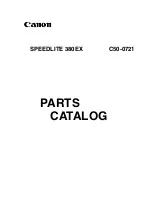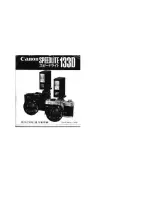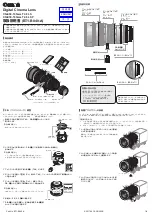
6
1.General
FinePix F601 Zoom (U/E/EG) SERVICE MANUAL
1-2.Camera Features
n
3.1 million effective pixels.
n
2832 x 2128 (6.03 million) recorded pixels Built-in 3 x zoom lens with a low-dispersion aspherical lens for
superb optical performance.
n
Compact and lightweight aluminum-magnesium alloy body.
n
Quick, responsive operation with 2-second startup and as little as 1 second between shots.
n
Auto focus with macro function (manual focus also available).
n
Automatic shooting modes that can be tailored to subjects in different photography conditions.
n
Shutter-priority AE, Aperture-priority AE and Manual exposure functions.
n
High-sensitivity photography (1M mode only).
n
Convenient preview function for quickly checking of your shots.
n
The 6.6× Honeycom zoom lens makes the most of the Super CCD Honeycom features (3× optical zoom coupled
with a superbly smooth (multi-level) digital zoom function offering up to 2.2× zooming at megapixel resolutions).
n
Playback zoom function (up to 18x).
n
Continuous shooting function.
n
Movie shooting function (640 × 480/320 × 240 pixels with sound).
n
Voice Memo function for easy photography information recording.
n
Audio Recording function.
n
1.5-inches 110,000-pixels low-temperature polysilicon TFT LCD monitor.
n
Recharge or connect to your PC simply by placing the FinePix F601 ZOOM in its cradle (sold separately).
n
Easy high-speed image file transfer via the USB connection.
n
Conforms to the new standard for digital camera file system*.
* Design rule for Camera File System
Explanation of Terms
DPOF:
Digital Print Order Format
DPOF is a format used for recording information on a storage media (image memory
card, etc.) that allows you to specify which of the frames shot using a digital camera
are printed and how many prints are made of each image.
EV:
A number that denotes exposure. The EV is determined by the brightness of the
subject and sensitivity (speed) of the film or CCD. The number is larger for bright
subjects and smaller for dark subjects. As the brightness of the subject changes, a
digital camera maintains the amount of light hitting the CCD at a constant level by
adjusting the aperture and shutter speed. When the amount of light striking the CCD
doubles, the EV increases by 1. Likewise, when the light is halved, the EV decreases
by 1.
JPEG:
Joint Photographics Experts Group
A file format used for compressing and saving color images. The compression ratio
can be selected, but the higher the compression ratio, the poorer the quality of the
expanded image.
Motion JPEG:
A type of AVI (Audio Video Interleave) file format that handles images and sound as a
single file. Images in the file are recorded in JPEG format. Motion JPEG can be played
back by QuickTime 3.0 or later.
PC Card:
A generic term for cards that meet the PC Card Standard.
PC Card Standard:
A standard for PC cards determined by the PCMCIA.
PCMCIA:
Personal Computer Memory Card International Association (US).
White Balance:
Whatever the kind of the light, the human eye adapts to it so that a white object still
looks white. On the other hand, devices such as digital cameras see a white subject
as white by first adjusting the color balance to suit the color of the ambient light around
the subject. This adjustment is called matching the white balance. A function that
automatically matches the white balance is called an Automatic White Balance function.







































